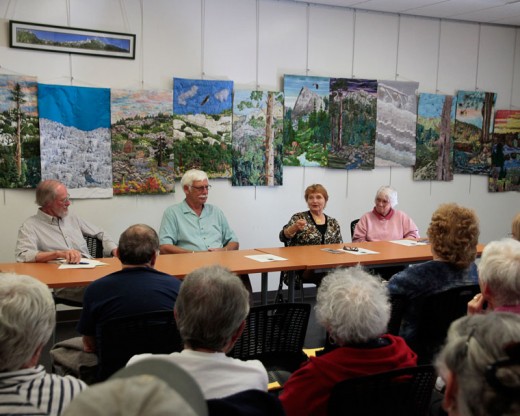
In 2015, Hill residents are wondering whether the fabled El Niño will deposit any snow or just rain. Fifty years ago, locals jumped off buildings into snow piles, enjoyed a small ski run, and could sled ride from Humber Park to Idyllwild School and continue from the Blue Bird Motel to Mountain Center.
These were a few of the stories that four long-time residents shared at Saturday’s panel discussion, which the Idyllwild Area Historic Society sponsored.
Pat Boss’s family arrived in Idyllwild in 1945 and ran the local hardware store where Village Hardware is today. He talked about living in the upstairs apartment. During the winter, he and his brother would jump from the balcony into 5-foot-deep snow piles below.
Boss and Marge Muir described the ski run, on Marion View Drive, which had a tow rope to pull skiers up the small hill so they could ski back down.
After snowstorms, plowing roads was much less efficient than today. Traffic was much less frequent, too. So kids would coax a ride to the Encino Road, which was at the end of Fern Valley Road (before Humber Park existed), attach a flashlight to their sleds and with a push, glide all the way to Idyllwild School.
But the real excitement and fun began with a short walk up to the Blue Bird Motel. There, they began another sled ride all the way to Mountain Center. Of course, a few parents followed this sled caravan in trucks so everyone could return home for hot chocolate (or schnapps), according to Boss.
But late afternoon sled rides and ski tows are not the only differences from 21st century Idyllwild. Becky Atilano, who moved here with her husband and twin daughters in 1964, Muir and Boss also described the entertainment center in town.
Before The Fort, a bowling alley, a swimming pool, a miniature golf course and a popular restaurant with a soda bar were located on that site.
“Luaus were held all the time there,” Boss said.
The Carriage Inn, a restaurant, was very popular, said Atilano, whose husband was the chef. Regular staffing included 23 waiters and waitresses. “It employed a lot of locals,” she said proudly.
The restaurant had a soda fountain for the kids. Across the street where Jo’An’s is now was Eleanor Park, where Atilano’s twins spent many afternoons after school playing.
In 1957, Muir, now a Pine Cove realtor, and her family moved here. They lived in a small cabin while building their house. When she went to the phone company to install a phone, the answer was, “Maybe in two years.” Eventually, they got that phone after much planning, such as moving into the uncompleted house.
Muir also discussed how she got the school district to provide bus service for Pine Cove students. “They said, ‘We have a bus if you’ll drive it,’” which is want she did, even in the snow.
After one snow fall, she and a friend encountered a visitor in the local grocery store. While discussing the hazards of driving in the snow, the visitor said, “I can only drive in Southern California.” Muir replied, “You’re in Southern California.”
Other local entertainment included fishing in Strawberry Creek, which was very popular with the kids, Muir said.
“There was always something for kids on Halloween, too,” she added.
For adults, apparently there were slot machines at the lodge in the KwikSet camp, according to Boss and Muir.
Bob Smith, an IAHS director, discussed his summers at his grandfather’s cabin in Pinewood. While he and his wife Adele moved here in 2001, he has been visiting the Hill since 1939. Since 1925, his family has had a cabin, which dates to 1878 and the lumber camp at Fuller Mill. Originally bought in the early 20th century for development, it became a family retreat for decades. They swam in a stream, slept in tents and spent evenings talking and playing board games around the campfire.
Despite the growth and new technology, all the reminiscences were of good friends and neighbors.
“The little things in a small town make it special,” Atilano said.
When Strawberry Plaza was being built, many locals protested the new development. A plan was formed to boycott the businesses in the plaza, according to Muir. But one of the first facilities to open was the Post Office, “and everybody had to go there,” she added.
As a realtor, Muir says many visitors and homebuyers tell her that they feel in love with the community, and she replies, “You really missed it. People are so wonderful.”
And Boss said, “The town really banded together, like it still does.”










